Diary Dates
Ongoing – WW1 Exhibition in the Museum
Saturday 14th October – Coffee Morning – the
Story of Harvest Festival
Saturday 11th November – Coffee Morning –
Remembering Remembrance Day
Wednesday 15th November – AGM 5pm - please
note new date and time.
Tuesday 5th December – Christmas Fayre
Christmas Fayre
Our Christmas Fayre this year will coincide with
Winterfest as usual, which this year is on Tuesday
5th December. Donations of tins, bottles,
chocolate bars, toiletries, cakes (on the day), brica-
brac, toys, handicrafts, raffle prizes etc will all
be very gratefully received! Please bring to the
museum at your earliest convenience.
September 100 Club
No. 1 June Osman £20
No. 15 Lyn Bearcroft £10
No. 80 Margaret Cook £5
Open Day Success
Saturday 9th September
Visitors to our Open Day were able to see not just
the usual museum displays but also the work that
goes on behind the scenes including how artefacts
are cleaned and documented, how the
photographic archive is managed, and what is held
in the museum's archive store. A range of
children's activities was on offer and the museum's
Express Cafe had a tasty selection of cakes. Thank
you to all our volunteers and visitors.
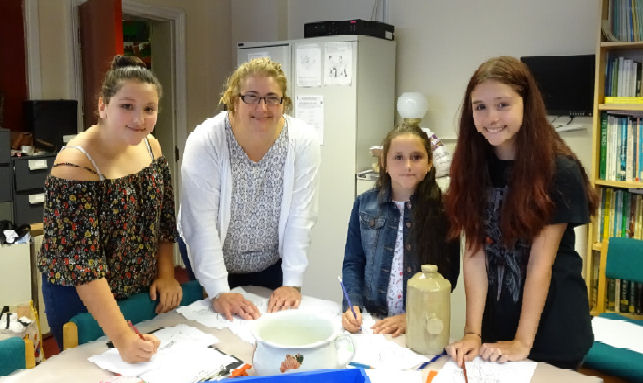
If you are reading a printed copy of this newsletter,
you will note the above photo is in black and
white. This is to keep the museum’s printing costs
down. If you have an email address and would
like to receive this newsletter electronically, please
email Jen at olinjen.price@btinternet.com or
myself at sallymurphy@talktalk.net and we will
add you to the e-mailing list. This will not only
save the museum money but will enable you to see
the photos in glorious colour!
Don’t forget to spend your old style £1 coins by
15th October. After that date only banks will take
them.
My memories of Ebbw
Vale Garden Festival
25 years on…
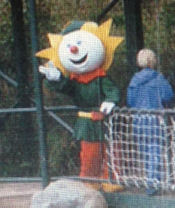 If you visited the Festival shops in
August, you will have seen the
exhibition to mark the 25 year
anniversary of the Garden Festival at Ebbw Vale.
The Festival ran from 1st May to 4th October 1992.
The idea of Garden Festivals started in Germany
after the Second World War as a way of
reclaiming derelict land. The first UK garden
festival was in Liverpool in 1984 followed by
Stoke-on-Trent in 1986, Glasgow in 1988 and
Gateshead in 1990.
If you visited the Festival shops in
August, you will have seen the
exhibition to mark the 25 year
anniversary of the Garden Festival at Ebbw Vale.
The Festival ran from 1st May to 4th October 1992.
The idea of Garden Festivals started in Germany
after the Second World War as a way of
reclaiming derelict land. The first UK garden
festival was in Liverpool in 1984 followed by
Stoke-on-Trent in 1986, Glasgow in 1988 and
Gateshead in 1990.
My husband and I both bought season tickets for
the Festival (which I still have) and together with
our daughter, then two, we visited at every
opportunity. We loved it – it was like having a
theme park on our doorstep! It was billed as ‘The
Event of the Decade’ and I still have a day
map/programme for 27th August 1992 along with
the summer programme for June to October.
The site covered 142 acres and included man-made
lakes, complete with waterfall that you could walk
under, a beach area, dozens of exhibition areas,
play areas for children and even fair rides
including a carousel, bob sleigh ride (‘The Cresta
Serpent Toboggan Run’) and, to my delight, a
compact rollercoaster that ran in very fast tight
circles and was not for the faint-hearted! And of
course there were the many food outlets where you
could literally eat your way around the world.
And of course we mustn’t forget the dozens of
gardens such as the Black & White garden, the
Star-trekker
Garden, the
Rupert Bear
Garden and my
two year old’s
favourite, the
Garden of
Welsh Myth and
Magic complete with moving, roaring dragons!
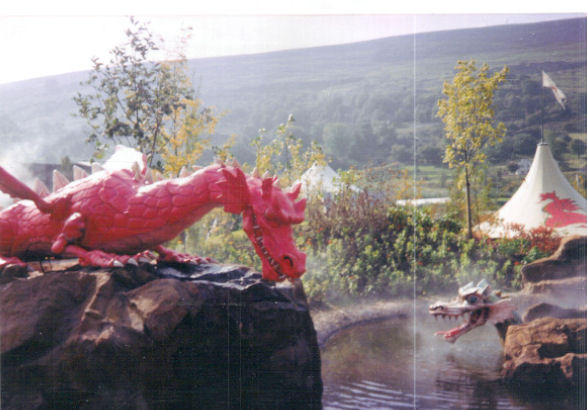
As the site was so large (and very hilly), a land
train made it easier to get around, while the
funicular mountain railway took you up to the
Wetlands and Opencast Discovery Centre. If you
were feeling fit and fancied a challenge then you
could take a short cut up the ‘Stairway to the
Stars’ made up of hundreds of wooden steps
leading from the beach area on the valley floor all
the way up to where the shops are today. In this
area you would find the Cadbury play area and the
reconstruction of the home town of Fireman Sam
amongst other things.
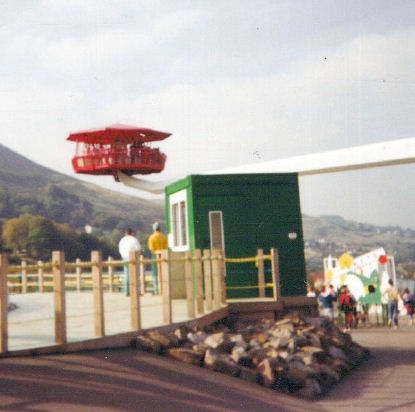
For a bird’s eye view of all
the Festival had to offer
there was always the Sky
Shuttle pictured here.
Each week brought
something new to see, with
ever changing flower
displays, music
extravaganzas, dancing displays and even reenactments
of Civil War battles in costume.
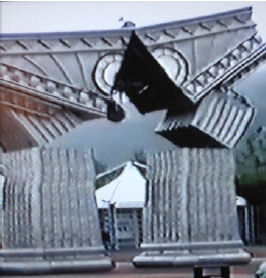
Remember the clock? Every hour it would break
apart and skeletons holding hour glasses would
remind us that time waits
for no man. Certainly the
last 25 years have flown
by.
In addition to all the
permanent exhibits, each
week or so saw a different
theme. 13th-22nd June was ‘Kiss a Frog Week’ where romance was the theme
and featured harp music, poetry and choirs whilst
23rd–27th June was ‘Santa’s Summer Season’ with
carol singing around the Christmas Tree with the
Salvation Army Band, Santa’s Christmas Grotto,
the Festival’s own ice-rink and even some ‘real’
snow.
27th July – 2nd August was ‘Pick Up A Party’ week
with garden parties complete with jelly and icecream,
pass the parcel and ‘The Glengettie Mad
Hatter’s Tea Party’ with Alice in Wonderland.
12th-18th August was billed as ‘A Whale of a Time’
with sun, sea and sand centred, of course, around
the beach area where you could sing along to sea
shanties and join in ‘Hi De Hi Games’ including ‘Glamorous Granny’ and ‘Knobbly Knees’
competitions. It’s no wonder the Ebbw Vale
Garden Festival is considered to be the most
successful of them all.
But all too soon the summer of ’92 came to an end.
I was there at the closing ceremony on 4th October,
camcorder in hand, and I must confess to a lump in
my throat as Gryff took to the stage and the lady
soloist sang ‘We’ll keep a welcome in the
hillside…’.
I have over 75 minutes of footage filmed on my
father’s camcorder and I have selected a few
short clips for the museum’s Facebook page
including an aerial shot taken from the Sky
Shuttle, so mosey on over and take a look.
Sally Murphy
Chip Shops
Chip shops these
days often sell all
sorts of meals but
as a child and
teenager (1950s –
early 1960s) my
recollection is that
they sold fish and chips and not a lot else. I
suppose everyone has their favourite chip shop but
there were only really two that I used in
Abertillery. One was in Tillery Road but I only
used that if I was at my grandparents as they lived
in nearby Greenmeadow Terrace. What I
particularly remember about that chip shop is that
they also sold wet fish and that is where my
grandmother bought hers, and my mother too I
suppose.
The fish and chip shop I used most, usually on the
way home from the cinema, was Deasey’s at the
bottom of Tillery Street. The chips cost 4d; I’m
sure they always cost 4d although commonsense
tells me that the price must have gone up during
that time. Anyway, the chips were served in a
wedge-shaped greaseproof bag and wrapped in
newspaper. You didn’t say in those days you
would have them to take away, it was “open or
wrapped?” I sometimes bought something called a ‘pattie’ which also cost 4d. It comprised two large
slices of potato with something (minced meat?) in
the middle and the whole thing cooked in batter. I
can still see Deasey’s in my mind – the bottles of
pop on the shelves and the chipping machine in
view.
Jen Price
Pram Race
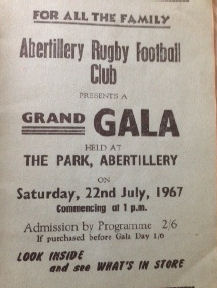 Recently a
programme was
given to the museum
relating to a ‘Grand
Gala’ held 50 years
ago at Abertillery
Park on Saturday,
22nd July 1967. The
event was sponsored
by Abertillery Rugby
Football Club and
admission cost 2/6.
Recently a
programme was
given to the museum
relating to a ‘Grand
Gala’ held 50 years
ago at Abertillery
Park on Saturday,
22nd July 1967. The
event was sponsored
by Abertillery Rugby
Football Club and
admission cost 2/6.
Events included
seven-a-side rugby, donkey races, tug-of-war
heats, trampoline displays and a display of sky
diving. But perhaps the most unusual event of the
day was a ‘Pram Race’. The race started outside
Abertillery Rugby Club. The following is taken
from the programme:-
Each club to enter one team (2 persons). One to
sit in the pram, the other to wheel the pram, this
will be reversed at each stop on route. At each
stop all contestants will consume half a pint of
beer before proceeding to the next stop and so on
until half a pint at the finishing post.
Start at Abertillery Rugby Club, proceed up
Station Hill to Highbury Club, across Foundry
Bridge into Church Street to Rolling Mill, proceed
on to traffic lights, turn left across Market Street,
turn right to Somerset Hotel, down Commercial
Street to Bush Hotel, proceed to Abertillery Rugby
Club and finish.
Where you there that day? Did you take part in the
pram race? We would love to hear your account of
it!
Sally Murphy
The Welsh National Anthem
Most of us know how to sing the Welsh National
Anthem in Welsh, if only the first few lines, but
how many of us actually know the meaning of
what we are singing? The following is a
translation that I found many years ago whilst
helping my daughter research a school project.
Not understanding a word of Welsh, I don’t know
how literal the translation is but these words fit the
music perfectly and makes one realise just how
patriotic a song it really is…!
Old Land of My Father
So Dear Unto me
Famed land of the minstrel
Fair home of the free
Thy warriors who wielded
Undaunted thy sword
For freedom their life blood has poured
Wales, Wales, true am I to Wales
While seas surge around
We raise the sound
Oh live ye loved land evermore.
Sally Murphy
Go Dancing
Get your dancing shoes on and head up to Blaina
Community Centre (next to Police Station) where
a warm welcome awaits you for an evening of
Modern Sequence Dancing. Every Friday 8-10pm,
Entrance £2.
Museum Matters
Religion in Gwent
In our museum are a number of artefacts, photographs and histories of the different Christian churches of our area. The beginning of religious worship began with
the Druids, who instructed people in the mysteries of the sun, moon and stars. They believed that at death the spirit did not perish but passed into other bodies. The Romans worshipped different gods. At Caerleon was a stone altar dedicated to Mithras, it is believed that a temple set apart for the worship of this deity stood on the site of the present old church.
It is almost impossible to say at what period, and by whom, Christianity was first introduced into these parts. Some early writers state that the Apostles themselves first brought the light to these shores. We may feel sure that as Caerleon was one of the chief Roman centres in these islands, Christianity probably reached these parts as early as in any other districts in the country. Ancient records say that the family of Caratacus was taken to Rome; among the captives were Eurgain, his daughter, then merely a child, in whom the Emperor Claudius was so interested that he immediately sought a suitable Roman into whose care he could with safety entrust the child Rufina. She was a great favourite with the Roman nobility with his British princess known as Claudia Rufina. Claudia was converted to Christianity by her guardian, who had long been suspected, and was on one occasion brought to trial for superstition.
Though she was declared innocent of the charges brought against her, there can be little doubt that the “foreign superstition " of which she was accused was no other than Christianity, the true faith. In course of time Claudia was married to Rufus Pudens, a Roman senator, who had held high office in civil and military life in Britain, but had now retired to his estates in Rome. The wedding was a scene of great magnificence, and a celebrated Latin poet, who was living in Rome at the time, wrote a poem in honour of the occasion, in which he speaks of her beauty. "Our Claudia see, true Roman, though she springs from a long line of Britain's painted kings ; Italia's self might claim so fair a face, And Athens envy her matchless grace."
Claudia converted her husband to Christianity, proof is found in St. Paul's Second Epistle to Timothy, at the close of the Epistle, he mentions Claudia, Pudens her husband, and Linus, a brother who was born after the family had been carried to Rome. We have the names of the children of a prince of ancient Caerleon set down by St. Paul himself. Historians tell us that 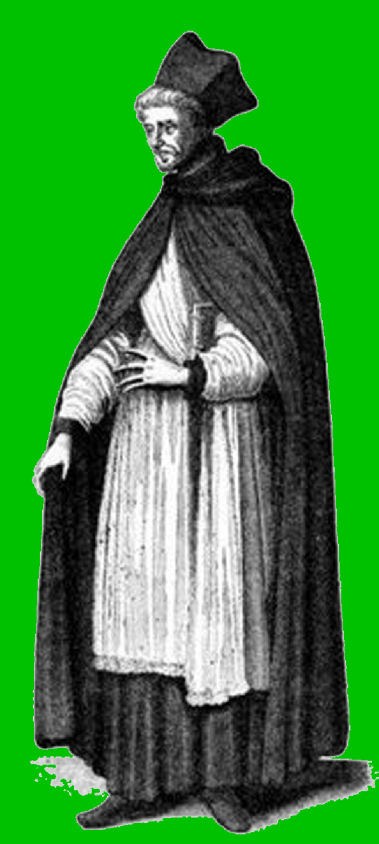 Linus was afterwards elected Bishop of Rome, and died the death of a martyr. Claudia and Pudens had four sons, one of whom Timotheus devoted himself to Christianity diligently instructing all who came to him in the Christian faith. At a National Council held at Winchester in the year 155, Christianity was established as the national religion, in place of Druidism and the false gods of the Romans. When Diocletian was Emperor (285-305), the Christian Church throughout the Western world suffered a period of persecution and bloodshed. In his scheme for the reform of the Empire, which he feared was then in a state of decay, he included the restoration of the worship of the old gods of the Romans, and the recognition of the divinity of the Emperor, which they must worship. This act the Christians opposed, but Diocletian hoped to crush them completely by severe edicts and persecution.
Linus was afterwards elected Bishop of Rome, and died the death of a martyr. Claudia and Pudens had four sons, one of whom Timotheus devoted himself to Christianity diligently instructing all who came to him in the Christian faith. At a National Council held at Winchester in the year 155, Christianity was established as the national religion, in place of Druidism and the false gods of the Romans. When Diocletian was Emperor (285-305), the Christian Church throughout the Western world suffered a period of persecution and bloodshed. In his scheme for the reform of the Empire, which he feared was then in a state of decay, he included the restoration of the worship of the old gods of the Romans, and the recognition of the divinity of the Emperor, which they must worship. This act the Christians opposed, but Diocletian hoped to crush them completely by severe edicts and persecution.
Historians tell us that the first nine onslaughts of the persecution did not reach this island, but the tenth and last wave broke upon these shores with a cruel force.
At Caerleon, where its fury, brutality and merciless cruelty were first felt, we read that on the first day of July, 303, the Christians were assembled together for worship when the Roman soldiers, at a given signal, rushed in upon them, seized all, and bore them to prison. When the Roman officers found that the prison would not contain all the Christians they had seized, the order was issued that they were to be put to death. Among the prominent Christians in Caerleon at the time were Amphibalus the Bishop, and Julius and Aaron, two natives of the city who assisted him in his labours. Julius and Aaron fell under the blows of their cruel persecutors, and at a later date two chapels were erected to commemorate their martyrdom. The spot where the church of St. Julian stood is now occupied by the stable or barn adjoining the old mansion of St. Julian’s.
The surrounding district on the northern outskirts of Newport also gives its name to St Julian. The site of the chapel of St. Aaron is less certain, but was probably near the old Roman camp of Penrhos, half a mile to the north of Caerleon. A few Christians escaped from the slaughter to the woods and mountains, amongst them were Amphibalus, Bishop of Caerleon, and principal of its college. The venerable old man escaped to Verulamium, near the present St. Albans in Hertfordshire, he sought shelter in the house of Alban, one of his former pupils.
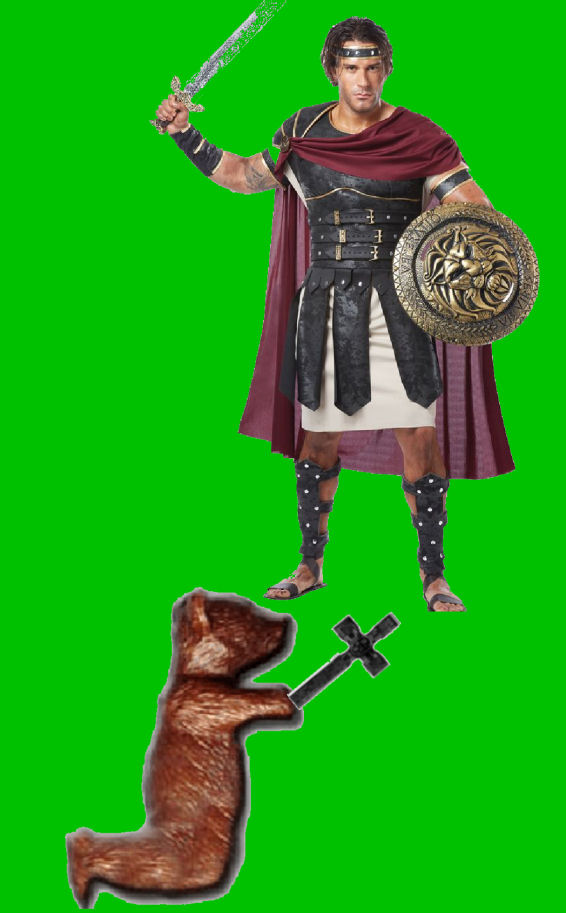 The Roman soldiers traced him to Verulamium. Alban had been converted by the aged Amphibalus, and when the soldiers approached his dwelling,he put on the clothing of his guest, and offered himself to the soldiers in his place. Alban, refusing to deny his faith, was cruelly beheaded, Amphibalus, now at the mercy of the Romans was brought out and stoned to death.
The Roman soldiers traced him to Verulamium. Alban had been converted by the aged Amphibalus, and when the soldiers approached his dwelling,he put on the clothing of his guest, and offered himself to the soldiers in his place. Alban, refusing to deny his faith, was cruelly beheaded, Amphibalus, now at the mercy of the Romans was brought out and stoned to death.
Don Bearcroft, Curator


